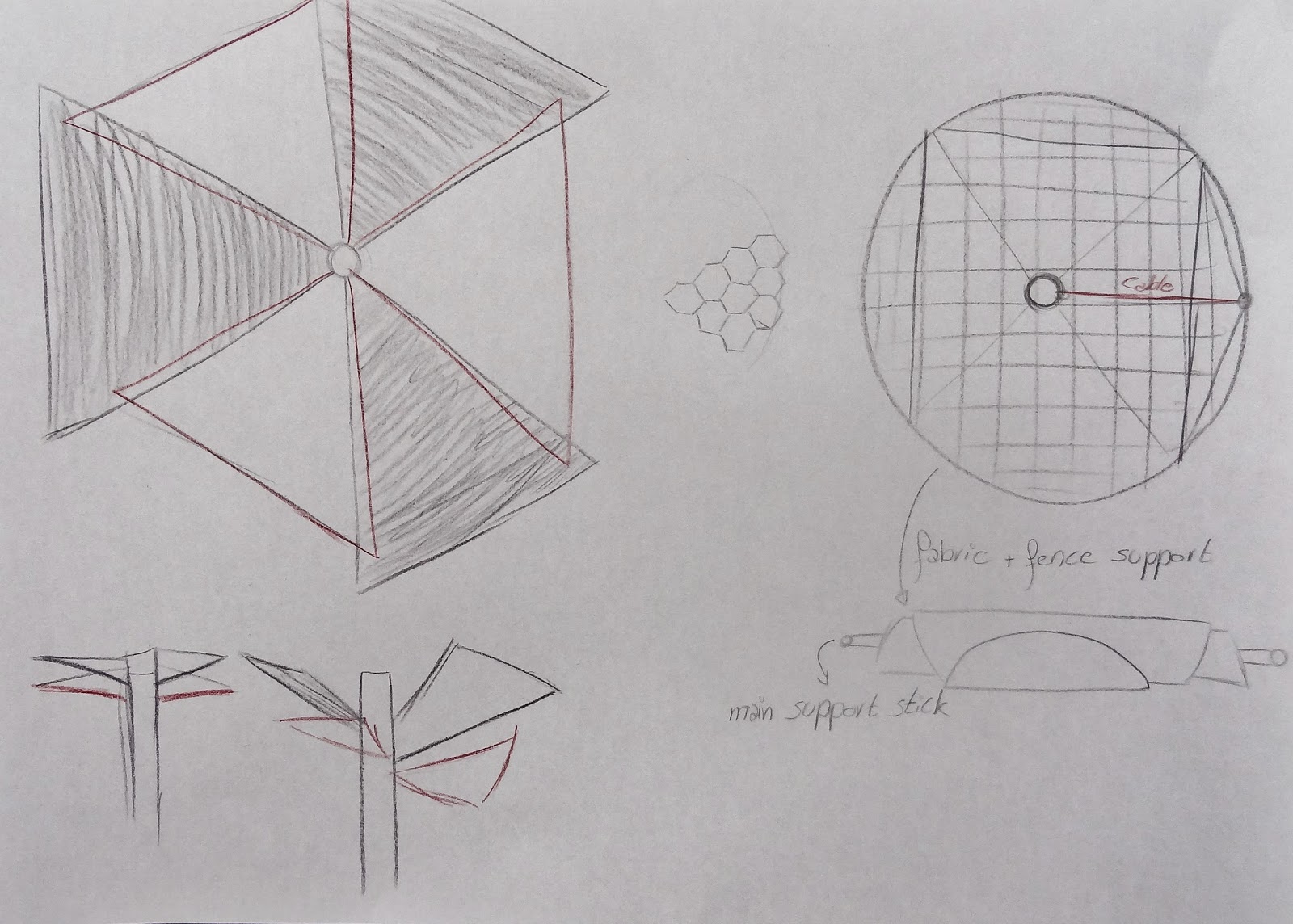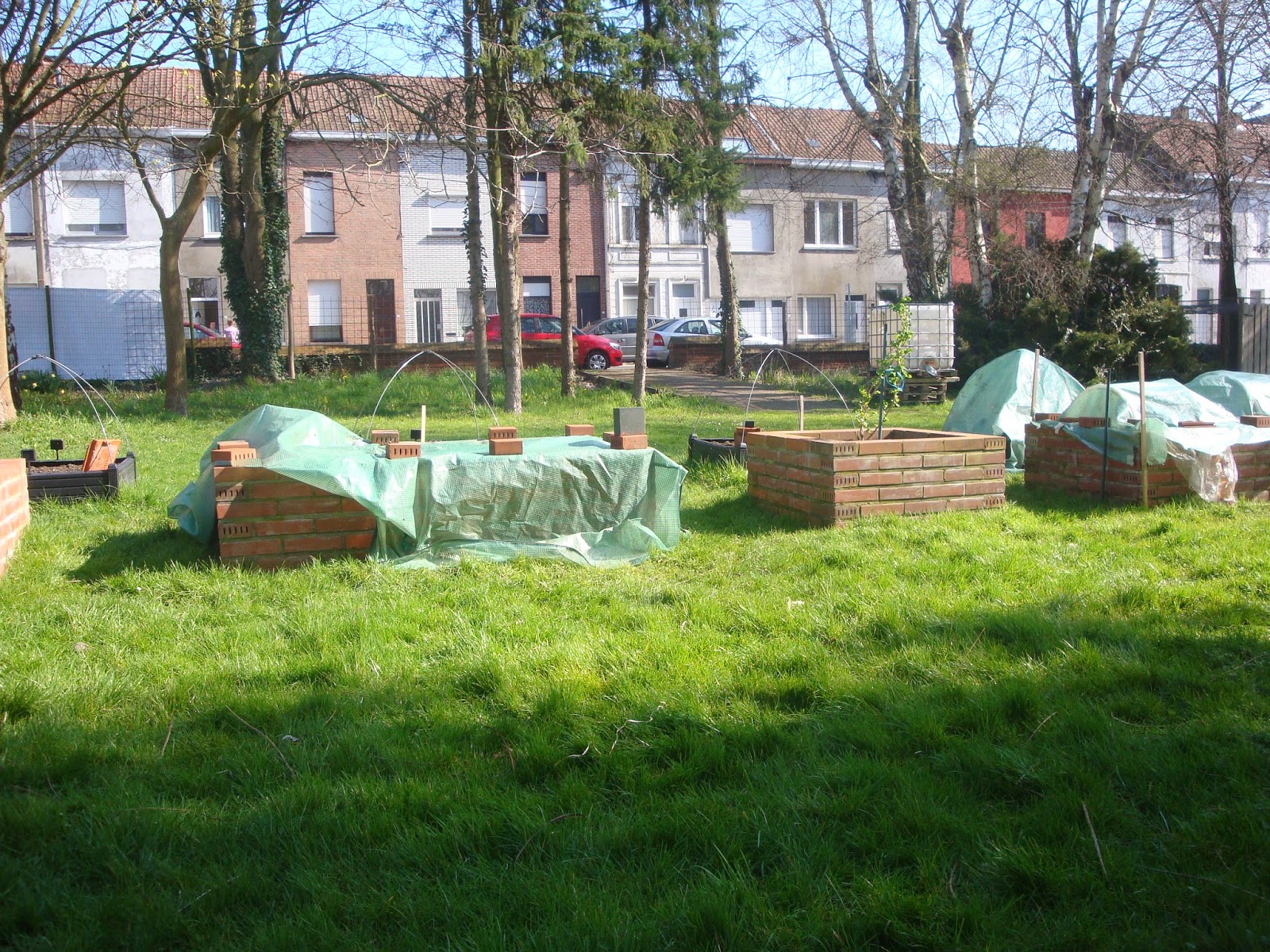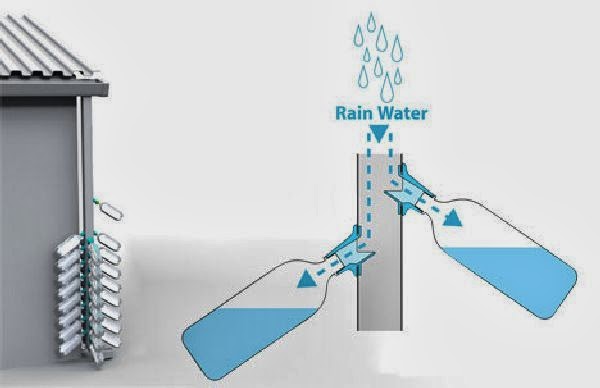Mondaymorning 31/03 we presentated our concept to the jury, this is the most important feedback we got:
- Use a barrel! by connecting the rain catcher to a barrel it's more stable and you don't have to put something in the ground
- Make sure it's an strong fabric
- Vandalism proof ?
- strong enough?
maandag 31 maart 2014
FINAL CONCEPT
After discussing the different concept variations, we choose the following as our final concept for the concept presentation of monday.
To tap the water we drill a hole into the central tube and attach a tap in it. A garden tube can be attached on it to let the water flow to the reservoirs.
The product we designed is an independent catcher with a surface of 3x3m square.
To provide stability to the catcher, we drill a wooden pole (standard fence part) approximately 1m into the ground. The catcher also functions as a parasol in sunny days and has a standing table for the gardeners to chat/BBQ/ have a drink....
For the construction we chose to work with a thermoplastic canvas sheets that can be ironed (DIY) onto eachother. We have to test how thick and/or reinforced the fabric has to be to withstand the forces of nature (wind, rain, snow...).
For the bended tubes we choose standard PVC tubes for electrical applications + their connection parts, which means they can be found easily and cheap. Also the central tube is made of PVC and guides the water downside. PVC is quite strong and resists outdoor conditions.
To hold everything in tension we'll work with washing line ropes; they are pretty strong and cheaper than steel cable.
To fix the hole catcher into the ground, we choose here to slam a wooden pole into the ground and then just shove the pvc tube over it. Then a pen can be put through those 2 to lock it from being picked away.
To tap the water we drill a hole into the central tube and attach a tap in it. A garden tube can be attached on it to let the water flow to the reservoirs.
zaterdag 29 maart 2014
CHOSEN CONCEPT VARIATIONS
The original concept was all about gathering the rain underneath the catcher. This gave us a lot of problems because the connections between the different barrels and the catcher itself are differnent with every barrel.
#1 : we put the catcher onto a tripod
#2 : me make our product like a standard parasol, that way you can put the catcher in the hole in a gardentable.
Our focus on this project is the simplicity of the product. The DIY-use is our main focus. With our current solution is very hard to think about one specific connection that fits with every barrel.
Another problem is the volume of the barrel. A standard barrel of 160 litres is to small and the cubic barrel of 1000 litres is way too big for 9 m^2.
Because of all these problems we started thinking in slightly another direction. Now we want to create rainwatercatchers apart from the barrel. This means we can connect multiple catchers to the same barrel with some tupes or some hoses.
The pictures underneath show some solutions for the anchoring into the ground.
#3: we fixate our pole into the ground with a standard metal anchor for fences. This is the most easy solutions, it's stronger than the others and very cheap.
vrijdag 28 maart 2014
CONCEPT FEEDBACK CLIENT
Today we went back to the client with prototype 1 and 2. We also showed our designproces and some different ideas.
She said she liked prototype 2 the most because of the shape.
Feedback prototype 1:
Positive:
- If you stand around the table you have a clear sight, the structure is not in your way
- If would be great if we could make this prototype using a simple drying rack
- nice double function, the bartable is great
- you can dry your clothes if you attach some more ropes
Negative:
- strong enough?
- the ropes should be attached to the ground instead of to the barrel itself.
- stability
Feedback prototype 2:
Positive:
- shape was very nice, like a flower
- simple DIY structure
- nice double function, she really likes the bartable
- with some extra ropes you can dry your clothes
Negative:
- sight if you stand around the table
- vandalismproof?
- stability
Because DIY is very important we choose for prototype 2, also because of its nice shape.
We will make some more sketches of the idea and start to work out the technical stuff.
IDEA SELECTION
We gave all the ideas a score on the different factors (demands/wishes) to become a final concept to work out.
These were the results:
The flexible raincatching system came out the best.
We will work further on this concept to optimalise it for DIY-use because some similar benchmarks already exist but not as a DIY-product. This will be our main goal for the final product.
These were the results:
The flexible raincatching system came out the best.
We will work further on this concept to optimalise it for DIY-use because some similar benchmarks already exist but not as a DIY-product. This will be our main goal for the final product.
PROTOTYPE #3
The third prototype is like an arc to put above the entrance of the garden. The arc is mad of a impermeable fabric supported by two barrels to collect the downfalling rainwater.
Positive feedback
Negative feedback
Makeability score: 5 (1/2 hour)
Positive feedback
- Expected: nice idea
- Unexpected: /
- Expected: stability
- Unexpected: /
Makeability score: 5 (1/2 hour)
donderdag 27 maart 2014
PROTOTYPE #2
The second prototype is in fact an inverted umbrella, with ropes to prevent the mechanism against breaking due to wind forces.
Positive feedback
Negative feedback
Makeability score: 2 (2 hour)
Positive feedback
- Expected: easy foldable (like an umbrella)
- Unexpected: /
- Expected: folding mechanism is more complex than prototype #1
- Unexpected: /
Makeability score: 2 (2 hour)
PROTOTYPE #1
At first we built the structure: four flexible wood tubes attached to a circular surface, the standing table, with four
strings (steel cables). Inside the base tube, is situated the water tank (barrel). The used scale is 1:5.
Then we
attached an impermeable fabric to the wood tubes, by this fabric will flow water
into the tank. And a net functions as a filter for leaves and branches from the surrounding trees.
Afterwards we tested the prototype with water to look if it's impermeable. We also checked if the prototype opened/closed in an easy way.
- Expected: Waterproof
- Unexpected: Flower lookalike
- Expected: /
- Unexpected: one of the wooden sticks broke after putting it up for the second time.
Makeability score: 4 (less than 1 hour)
woensdag 26 maart 2014
FIRST IDEAS
After brainstorming around the different demands & wishes, we started to take these ideas into concrete products. We became the following designs:
1st idea is an axis with watercatching leaves that can be folded open into a spiral.
2nd idea is similar to the first: the form of the leave is replaced by triangles for a larger surface. The fabric is supported by fence nets.
3rd idea is to use the entrance of the garden as a water collector. This could be done with two barrels on both sides of the entrance that capture the water from the roof inbetween.
4th idea is based on one of the benchmarks (rack of barrels). This idea attaches a foldable roof to the rack to catch the rainwater.
5th idea: rain water mostly doesn't fall down vertically cause of the wind. This idea is a turnable rainwater catcher to optimalise the angle of the used surface.
6th idea is to use the industrial m³ fluid containers (1000l, they already got 1 on the site for free). The idea was to use the protection frame as a foldable catcher (fold it upside instead of downside).
7th idea is a lightweight structure with flexible tubes (pvc) hold on form by some steel cables.
We discussed the form of the catching surface. The consensus was that a square surface has the best surface occupation (20% more than circle...) This idea is one of our favorites because it can be easy made as a DIY'er!
An expansion of the previous idea is to close it automatically when the collector (bag) is full.
We became the idea by watching the timelapse of a swimming pool. We use the position of the floating band to regulate the opening of the flexible catcher.
We became the idea by watching the timelapse of a swimming pool. We use the position of the floating band to regulate the opening of the flexible catcher.
An extra feature could be a standing table if we use oil barrels to collect the water. These are 90cm high, so ergonomic height for standing tables, as used for parties/apero's. The catcher could also function as an umbrella for the people underneath. We think this could definitely be an extra trump for the urban garden!
8th idea we call the inverted umbrella. The catcher is folded open with an umbrella-like mechanism, but over the top so it becomes a cone to catch water. The central axis functions as a pipe to collect the water.
Because the site needs about 720 liters/week for watering the plants, we calculated we're going to need 40 m² to fulfill these needs. If we take 3x3m (9m²) for 1 catcher, we need 4 of them to catch enough water. Therefore we thought of making the catchers separate from the collectors by making them modular. As a DIY'er you could build as many catchers you need and them connect them on a central water tank (like the m³ industrial fluid tank).
We choose the last 2 ideas as the best ones to prototype.
Next thing we will do is go the DIY-shops and look for usable materials and make some prototypes + testing!
dinsdag 25 maart 2014
CALCULATIONS: How big is an ideal surface to maintain the garden?
We calculated how big our surface should be to have enough water for the whole garden.
In the garden there is 36 m^2 of ground where people cultivate.
In the garden there is 36 m^2 of ground where people cultivate.
In the summer they need the rain the most so we calculated how much it rains in this period.
This is 2,5 l / m^2 a day. (average)
We searched on internet how much water 1 m^2 needs to cultivate. We found 20 litres a week.
This leads to our calculations:
36 m^2 * 20l = 720 l /m^2 a week
Each weeks there falls 2,5*7 = 17,5 l of rain.
=> 720 l/ m^2 / 17,5 l = 41 m^2
This is a lot, because we want as much surface as possible we are thinking about a modular system with 9 m^2. In that way we can build multiple systems to put around the garden.
EXPLORATION DEMANDS & WISHES
Today we did some exploration about the different demands & wishes for the product.
We wrote down the demands & wishes in keywords on post-its.
Each of us had about 5 minutes to think about ideas for the different topics, mentionned on the different sheets. After 5 minutes we exchanged sheets and complement each other.
These were the results:
We wrote down the demands & wishes in keywords on post-its.
Each of us had about 5 minutes to think about ideas for the different topics, mentionned on the different sheets. After 5 minutes we exchanged sheets and complement each other.
These were the results:
Afterwards we discussed our different ideas and started to combine them into concrete solutions for the product.
THE GARDEN
These are pictures of the garden itself with the planters of 1 m^2 or 2m^2.
This is a typical 1 m^2 planter.
They allready have a big barrel of 1000 litres
LIST OF DEMANDS
Demands:
- anti frost
- lightweight
- cheap
- sunlight for the plants
- easy to build up and break down
- filter for the leaves
Wishes:
- a tap
- looks good in the garden
- recycling materials
- vandalism proof
- modular
- compact storage
- m^2 planters
- customizable
- anti frost
- lightweight
- cheap
- sunlight for the plants
- easy to build up and break down
- filter for the leaves
Wishes:
- a tap
- looks good in the garden
- recycling materials
- vandalism proof
- modular
- compact storage
- m^2 planters
- customizable
INTERVIEW WITH THE CLIENT
We had an appointment with our client at 10h and we asked her the following questions, these are the results:
- mobile ( permanent/ temporary)?
It should be temporary mobile, it would be nice if the system can be stored.
- fast and easy to set up and disassemble?
As fast as possible but strong enough.
- possibility to connect to a roof?
Not necessary
- how much water is needed?
They have allready one big storage tank of 1000 litres
- how much people use the storage tank?
25-30 people
- Compact?
Not necessary, the bigger the surface the water can be stored
- specific connections needed?
No, just one simple tap
- is the garden easy attainable?
Yes, it's an open garden with a big entrance
- are there any other applications for the water?
Yes, people can use it by the barbeque, to fill a children swimming pool in the summer,...
- need of a filter?
No need for a filter to make potable water, just to catch the leaves of the trees
- vandalism?
Yes it have to withstand forces and knives because not everyone is so kind. It's also a public garden so everyone can enter.
maandag 24 maart 2014
Abonneren op:
Reacties (Atom)






























































